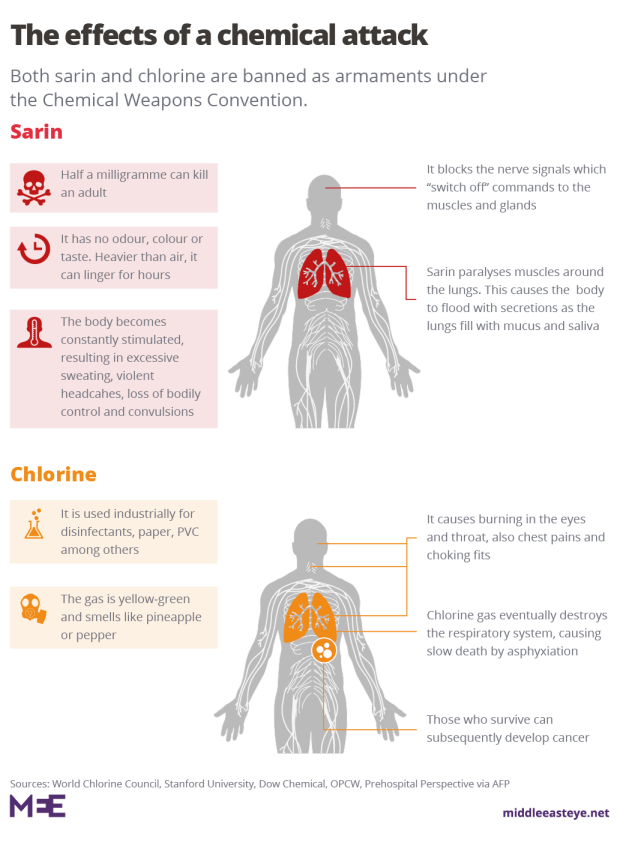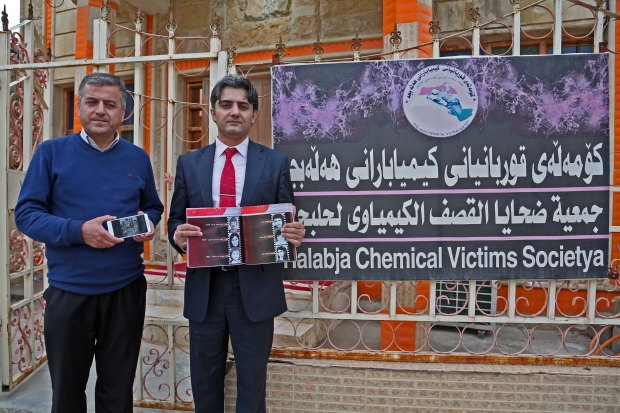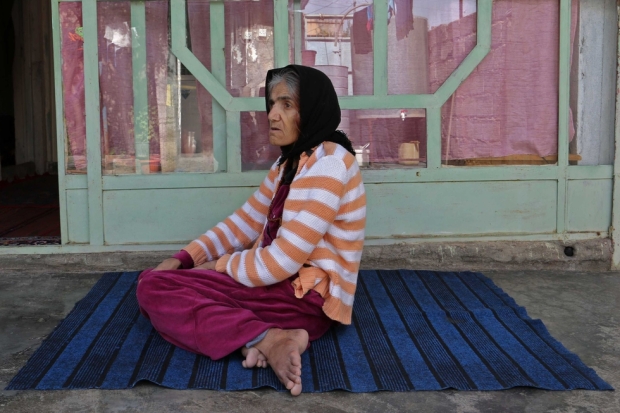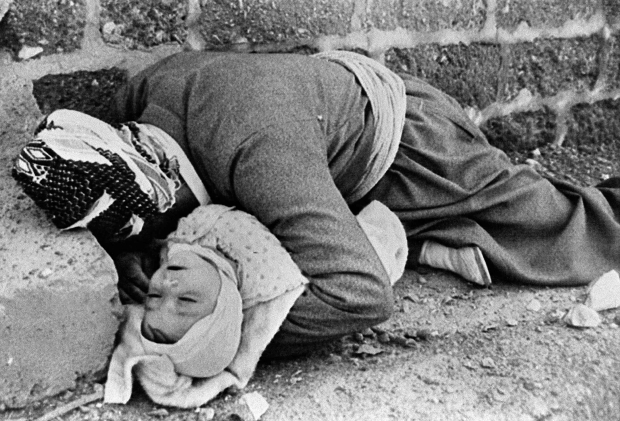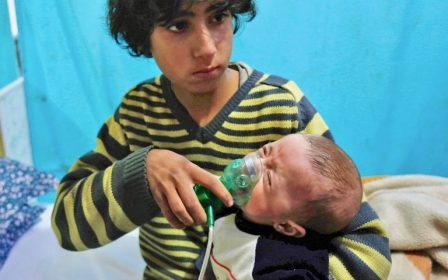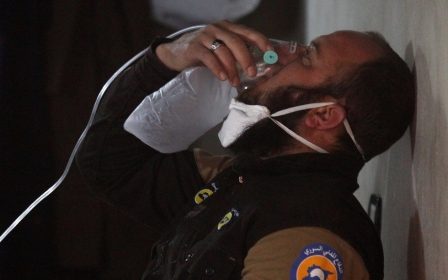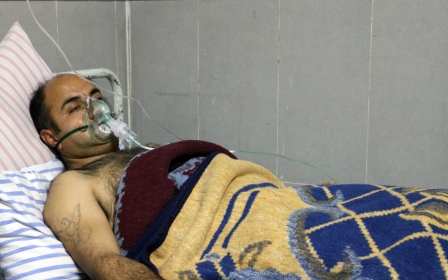Chemical attacks: How the nightmare of 1988 still haunts an Iraqi town
HALABJA, Iraq – Eager to welcome her guests, Nadjat Hussein brings out the baskets of fruit from the fridge in her neat and tidy kitchen.
She pauses, looks at the apples and then, with an instinctive wave of her hand, takes a step back as her eyes begin to well up with tears.
The fruit has a horrible resonance in the Iraqi border city of Halabja, scene of one of the worst chemical attacks in modern history.
A scent not dissimilar to apples was the first sign for many residents that mustard gas, sarin and cyanide were raining down from the skies on 16 March 1988.
The attack on the city - which had become a Kurdish centre of resistance to the government in Baghdad – was ordered by Iraqi leader Saddam Hussein and his cousin Ali Hassan al-Majid (later known as “Chemical Ali”) during the final stages of the Iran-Iraq war. The delivery of chemicals was cynically calculated to make the most of the prevailing winds.
New MEE newsletter: Jerusalem Dispatch
Sign up to get the latest insights and analysis on Israel-Palestine, alongside Turkey Unpacked and other MEE newsletters
In a matter of hours an estimated 5,000 Iraqi Kurds were killed, twice as many injured and hundreds of children orphaned without any remaining family.
Many of the survivors’ painful memories have since been reawakened by reports of chemical attacks in Eastern Ghouta, most recently a chlorine attack on al-Shifuniyah in late February.
Garda, Nadjat’s older sister, sits outside the front of the house in a small courtyard. She is huddled on the ground in her bare feet, her toes crooked, much like her hands.
It would have been easier if we had died back then
- Nadjat, survivor of Halabja chemical attack
Constantly she seems on the verge of tipping backwards. When she can no longer keep her balance, she leans forward and becomes a human bundle with her head buried in her hands.
For 24 hours each day, Garda is nurtured by her sisters. She can neither walk nor wash nor use the toilet on her own. There seems no way for her to summon the strength and use the little language she still possesses.
No one knows whether Garda can remember the day when her life changed forever. But Nadjat still harbours painful memories.
“We ran from the house when the bombs began to fall,” she recalls. “My father, mother, sister, me and Garda. All of a sudden we were blinded. But somehow Garda managed to find a water drain.”
As Nadjat speaks, Garda remains by her side, barely there, occasionally stirring in the air.
“Garda washed herself, her face, her feet and drank the water. She thought it would help. But instead she got worse. Later, the doctor told us the water had been contaminated."
Nadjat tries, amid tears, to illustrate on her own arms how the chemical gasses worked their way through Garda’s skin.
“It fell off. The skin burned and just started to fall off and she wasn’t able to move. Had it not been for someone that took her on their shoulders, then later in the back of a truck and again later on a horseback, then we would all be dead by now.”
Nadjat, who herself still suffers shortness of breath, attends a clinic every month, as do 2,400 fellow residents of Halabja. Their ailments number skin disease, chronic eye problems, mental issues, allergies and eczema.
“It would have been easier if we had died back then,” Nadjat says later. Garda, who has since suffered long-term nerve and brain damage, is beyond treatment.
Everyone carries a burden
Nadjat and most of her close family survived, albeit with chronic scarring, life-long medical conditions and traumatised for life. Ten of her wider family perished.
At the Halabja Chemical Victim Society, Hosmand Morad Mohammed recalls what happened to him in 1988.
As the attack happened his parents sent the then six-year-old, his siblings and their neighbours’ family towards the border with Iran. His parents were supposed to follow in their tracks: they never made it and, like Hosmand’s grandmother, four uncles and hundreds of others, ended up in one of Halabja’s mass graves.
“Everybody in Halabja has a bad story about the smell of apples,” says Mohammed, who is now a teacher at the Halabja Institute of Computer Science.
“When we talk about apples we remember the nightmare. The bodies we passed fleeing the city. Humans and animals. No one was spared. Today we can eat and even smell apples. But it is difficult. We just don’t like it.”
Hikmat Faeg Arif, 47, joins the conversation. “You cannot describe what happened in words. So many lost so much. Family, friends, homes, our city.”
You cannot describe what happened in words. So many lost so much. Family, friends, homes, our city
- Hikmat Faeg Arif
Like Hosmand, he is a board member of the small NGO, which continues to register the names of victims and missing persons in heavy notebooks. Their ultimate aim is to collect enough evidence to build an international lawsuit against the companies which they allege fed the Saddam regime with its chemical arsenal.
Everyone in Halabja carries the burden of their own personal loss. Arif produces an iPhone from his pocket, then displays a black-and-white family tree of 11 portraits.
“I was just 16 but already a part of the Peshmerga,” he says of his support for the anti-Saddam forces.
On the day of the attack he was stationed in the mountains of Qaradakh and could get no news of his family for a long time. The attack instantly killed Hikmat’s mother, eight siblings and a nephew. Seven months later his father died from his severe injuries. To this day his sister, who has lost half her sight, seeks treatment in Iran for her remaining eye.
The black cloud over Halabja
The residents of Halabja had been under attack from Saddam before, often hunkering in basements and underground hideouts.
But those shelters gave residents a false sense of security, explains archaeologist Hawar Nae-Madin Hawas, who was eight at the time. The poison proved impossible to keep out of homes, whose windows and doors had been destroyed by conventional raids.
Since the attack, traces of the chemicals have still been found in the soil and wider environment. Until a few years ago, the shelters were still deemed contaminated and dangerous.
“I recall people running around the streets acting like lunatics. Some were laughing. Some screaming.”
Bahar Mohammed Mahmoud, now 52, recalls how he saw one family die in front of her. “They were embracing each other,” she says. “A mum, dad and son in the middle of the street.”
She closes her eyes, as if she does not want what she saw to surface again.
“They were bleeding from their eyes and it looked like their eyes popped out of their heads. They looked like the devil. I will never forget it. Most people love the smell of apples. We didn’t know this was the smell of chemical weapons, until we saw people falling to the ground, running in the streets, screaming, shouting for help.”
Mahmoud starts to cry. Like Nadjat Hussein, she is also being treated at the medical clinic run by The Jiyan Foundation for damage to her respiratory system.
Even three decades after the attacks, there is still a litany of medical issues that doctors and nurses need to deal with, including chronic bronchitis, asthma and other infections, chronic eye injuries and skin conditions. While there are no figures, there are also reports of miscarriages and birth defects.
Salah Ahmad, president of the clinic, says: “There is a black cloud hanging over Halabja. You have to visit in order to feel it. So many carry such a heavy burden of grief from what happened.
“But like survivors from the Holocaust they still remember every comma, every dot. Despite 70 years having passed, they will never forget. And it is exactly the same for the people of Halabja. This is their Holocaust.
“But the difference is that most people in Halabja never received any help or professional treatment, until in recent years.“
Syria attacks reawaken nightmares
The events of March 1988 have been also been reawakened by more recent chemical attacks, notably those in the Syrian suburb of Eastern Ghouta.
The raids there in August 2013 – which killed between 500 and 1,700 people - revived the horror of Halabja, even though the two communities are in different countries, 1,200km apart.
At the time, the people of Halabja took to the streets to show support for the victims in Syrian and against the use of chemical weapons.
“I just can’t bear to watch it,” says Bahar Mohammed Mahmoud. “What is happening in Ghouta is what happened to us. This is Halabja all over again.”
Nadjat Hussein says between tears: “I relive the day. I remember everything when I see it in the news. I cry for Syria but at least people like you and the rest of the world can actually see what is happening. That wasn’t possible back then.”
Azad Mustafa Qader, a doctor at the Jiyan Foundation clinic, says that after the Ghouta attack, staff at the clinic noticed a rise in calls from patients.
“People were plain and simple scared. They believed that Halabja was next for another attack when they saw what happened in Ghouta.
“One lady told me how she saw all of her dead children in Ghouta. We had to arrange seminars in order to explain that Ghouta is in a totally different country.”
The scars which cannot heal
Today red, green and yellow apples are again on display at most of the street vendors in Halabja’s bazaar. But there are still reminders of the attack.
A supermarket named “16/3” after the date of the massacre. Endless graves at the cemeteries, a site where members of the Baath Party – of which Saddam was leader - are not allowed to enter. A 269-page book which reads like a chilling catalogue of those who perished, each page representing one family whose existence was erased.
And then there is the memorial museum, one of the first sights which greets visitors to Halabja and which documents the events and aftermath of that day. Outside lies a memorial depicting Omar Khawar, who died on the pavement clutching the body of Mohammed, one of his twin sons.
Borhun Hama Salh, now 58, is Khawar’s only surviving relative. He looks at a portrait of his deceased uncle hanging at the Halabja Chemical Victims Society.
“So many families died that day,” he says. “My uncle included. And yes, he has become a symbol of Halabja’s tragedy. But he is also a hero and so much more than that.
“Many families lost their loved ones. It is just stories repeating. But he also symbolises a bigger story. He is the symbol of the Kurdish nations.”
Salh has his own scars, including heart surgery which he blames on the gas attack, as well as the fact that it took his wife 17 years to become pregnant. He recounts the last hours of his uncle and cousin.
“A lot of families had gathered in the basements. But they fled when then chemical bombs started. A truck came to transport some of them but there was only room for a few families.
“My uncle let his own family go. And he continued on foot with his twin son Mohammed. But they didn’t make it. None of them did. He died in the middle of the pavement, 20 metres down the road.”
Today, city pollution has erased that distinct scent of apples in Halabja. The spot where Omar Khawar and his son died is unmarked.
But their legacy lives on at the museum, which also marks the passing of other notable Kurdish lives, including that of three-year-old refugee Alan Kurdi, who drowned while trying to reach Europe in September 2015.
Only time will tell if others also join them on the museum walls.
Middle East Eye delivers independent and unrivalled coverage and analysis of the Middle East, North Africa and beyond. To learn more about republishing this content and the associated fees, please fill out this form. More about MEE can be found here.



